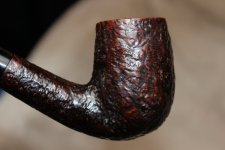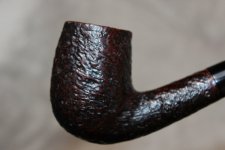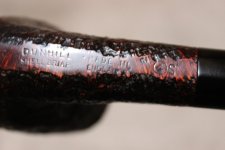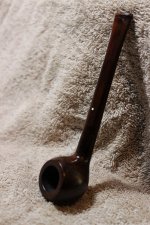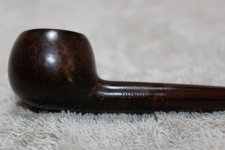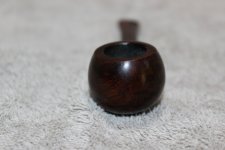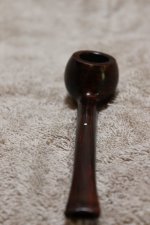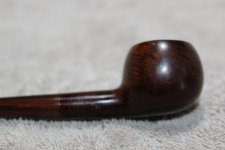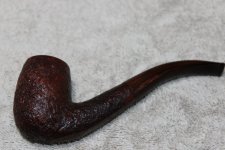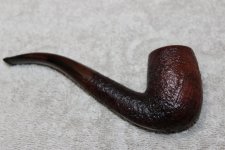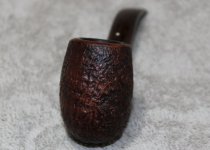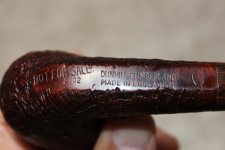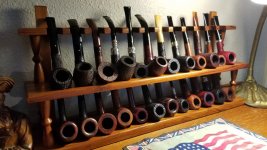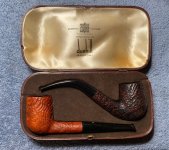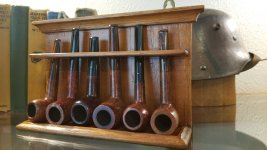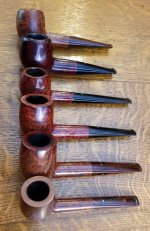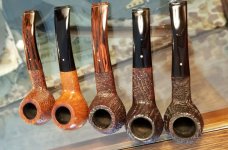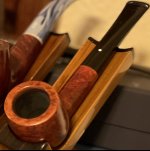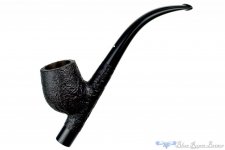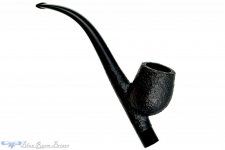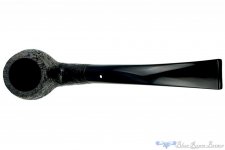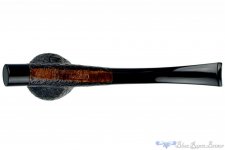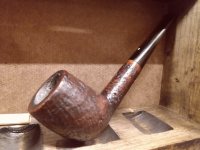Showoff Your Dunhill Pipes Here!
- Thread starter smokeybear
- Start date
You are using an out of date browser. It may not display this or other websites correctly.
You should upgrade or use an alternative browser.
You should upgrade or use an alternative browser.
SmokingPipes.com Updates
Watch for Updates Twice a Week
View attachment 91011View attachment 91012View attachment 91013View attachment 91014View attachment 91015
My oldest Dunhill is a 1949 Pot.
A great collection, thanks for sharing it. For some reason 1949 was an amazing year for Shells at Dunhill. I’ve seen a number of ’49s with outstanding sandblasts (like yours!).
Thx.A great collection, thanks for sharing it. For some reason 1949 was an amazing year for Shells at Dunhill. I’ve seen a number of ’49s with outstanding sandblasts (like yours!).
A stunning pair in every way! But for at least some completely obsessive Dunhill geeks the potentially thrilling fact about your birth year set (given how extraordinarily unlikely it is that you're wrong about the date) might be the "late King George" royal warrant of the case lining FIVE full years after Elizabeth II's accession.
That level of knowledge is above my pay grade, but good to know! Perhaps they had some old cases lying around the shop and finally got around to using them. I've encountered similar mix and match situations with late 30s - early 50s Kaywoodies.A stunning pair in every way! But for at least some completely obsessive Dunhill geeks the potentially thrilling fact about your birth year set (given how extraordinarily unlikely it is that you're wrong about the date) might be the "late King George" royal warrant of the case lining FIVE full years after Elizabeth II's accession.
The narrow issue here that has intrigued quite a number of what might be called Dunhill pipe antiquarians-- is what the rules might have been about English merchants' use of royal warrants, and the specific details of what they were obligated to do when a monarch who'd publicly endorsed them died.That level of knowledge is above my pay grade, but good to know! Perhaps they had some old cases lying around the shop and finally got around to using them. I've encountered similar mix and match situations with late 30s - early 50s Kaywoodies.
Whatever else, Dunhill makes it clear they (ie the rules and/or their enforcement) must have been pretty fuzzy.
My own working hypothesis has been that the authorities must have been pretty tolerant about allowing companies to use up everything and anything already on hand (and that moreover since it requires some time for a new monarch to dole out brand new warrants to whomever was chosen to regularly supply a vast number of products and services, there had to be a transition period).
Accordingly, my guess is that stationary, for example, could be fairly rapidly and economically changed to "the late King George" and then to "by appointment to Queen Elizabeth." On the other hand, I'd also guess by 1957 Dunhill's expensive leather "Ventage" cases (handcrafted individually to perfectly fit individual pipes) would have been very slow to sell, and the white silk lining printed prior to 1952 were used, accordingly, at an almost glacial pace.
70 years after the fact, I fear hopes have rather dimmed for a Dunhill inside man to chime in with first hand knowledge of what in fact Dunhill did or why. On the other hand, it may still be possible to ascertain what they were meant to do. . . .
Some of my patent era Shell finish pieces, again in a prewar Dunhill rack.
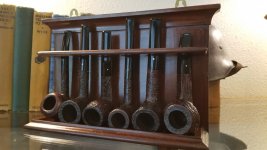
A couple more in this image, with the ones from above. One is a "black dot" from having its hole drilled down into the airway of the stem and the dot acting like a straw for tars over the decades. The prince next to it is unsmoked.
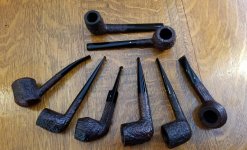

A couple more in this image, with the ones from above. One is a "black dot" from having its hole drilled down into the airway of the stem and the dot acting like a straw for tars over the decades. The prince next to it is unsmoked.

Some of my patent era Shell finish pieces, again in a prewar Dunhill rack.
A couple more in this image, with the ones from above. One is a "black dot" from having its hole drilled down into the airway of the stem and the dot acting like a straw for tars over the decades. The prince next to it is unsmoked.
View attachment 94828
Love the grain on the straight shell bulldog with the saddle stem.
They've really captured the shape of the old Ropp cherrywoods well with that rounded base.
Thanks for the kind words about the tall shell bulldog. I was very chuffed to pick it up when I found it. The rounded bottom cherrywood is a unique piece. I have only seen a couple others like it. They both smoke well to boot.
This is a Dunhill ODA 806 F/T from 1971. Over the years, it's gotten pretty dull. I forgot to take before pictures but the first pic is a pretty good recreation. I decided to refinish it, but achieved more of the tone of the late 80's rather than the bright magenta of the 70's. I'm pretty happy with it.
Before
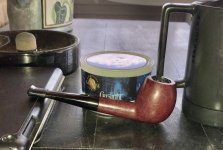
After
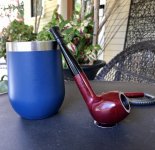
Before

After

I have noticed your liking for esoterica and the (slightly) unusualOrdered this weirdo last night:
View attachment 101243
View attachment 101244
View attachment 101245
View attachment 101246







